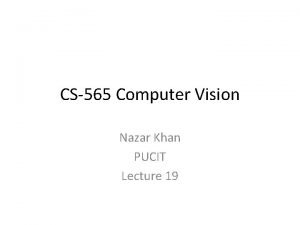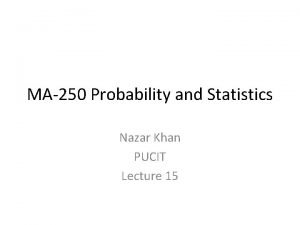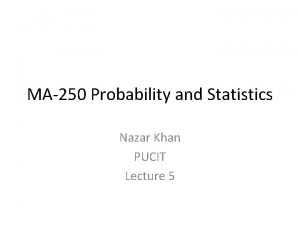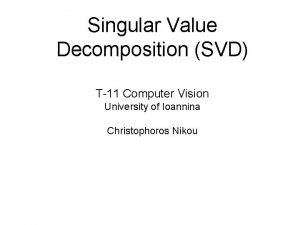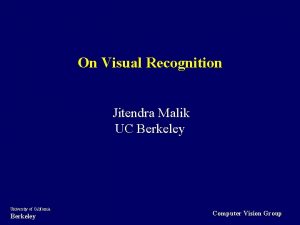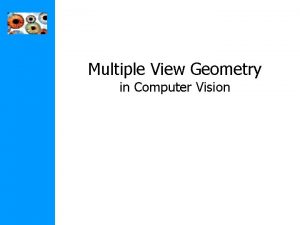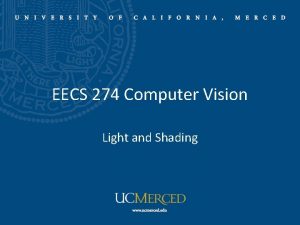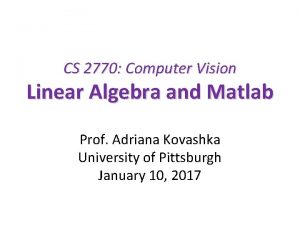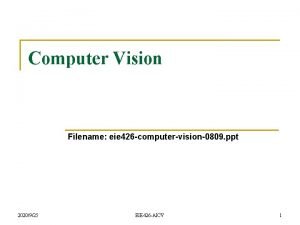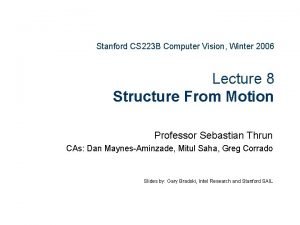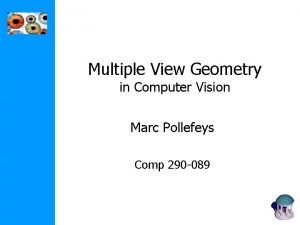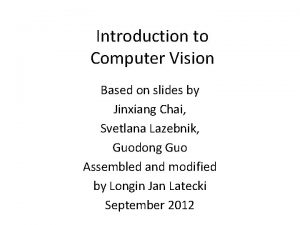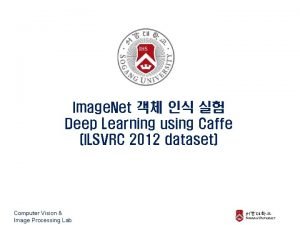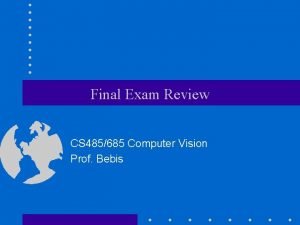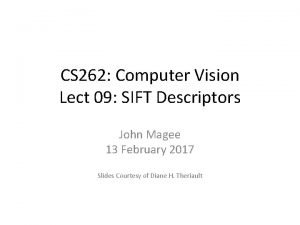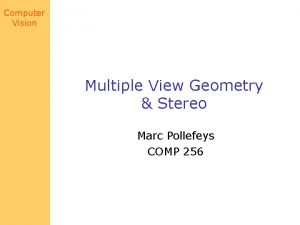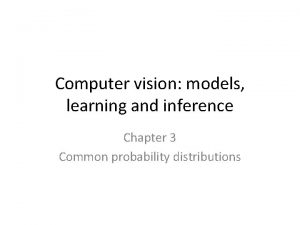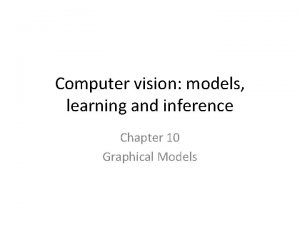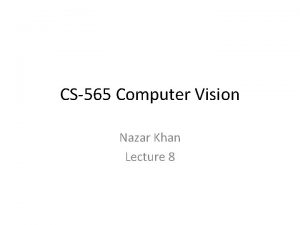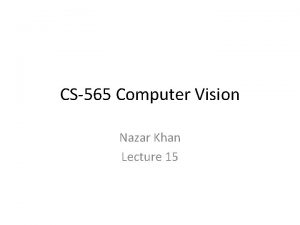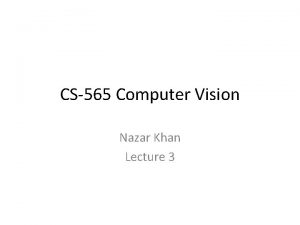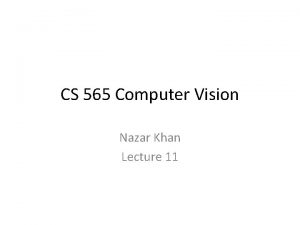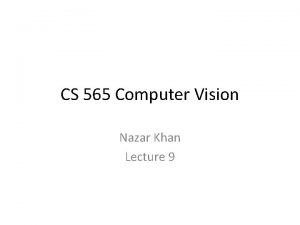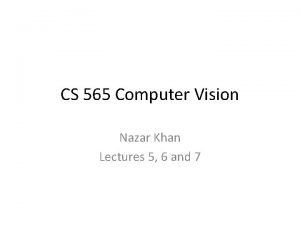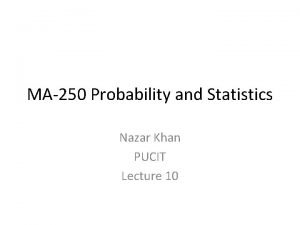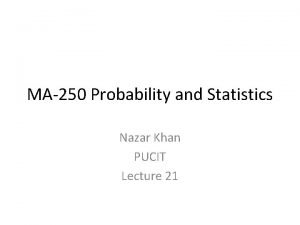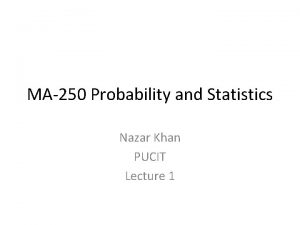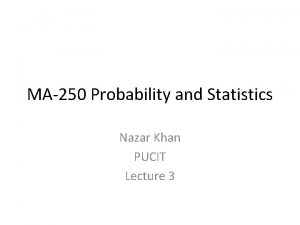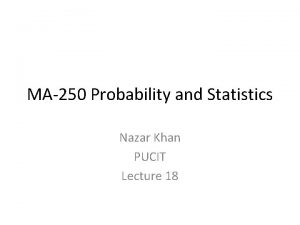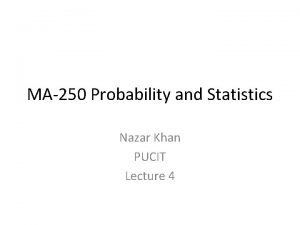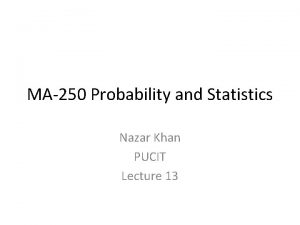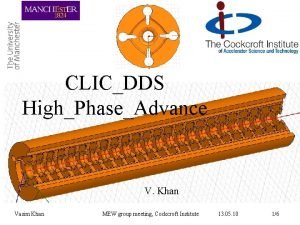CS565 Computer Vision Nazar Khan Lecture 2 A

































- Slides: 33

CS-565 Computer Vision Nazar Khan Lecture 2

A Note on Pre-Requisites • Some students are concerned about the pre-requisites – Linear Algebra – Probability – Calculus • We will cover some basics as they come along. • So don’t worry too much. • However, it will serve you well to read the Appendices of standard Computer Vision, Image Processing or Computer Graphics books. They are usually very helpful – Appendix from Rich Szeliski’s book – Appendix from Gonzalez & Woods’ book

Topics to be covered • Image types • Sampling and Quantization • Noise models

Image Concepts • What is a grayscale image? – A mapping from a rectangular domain to the range • The domain is called image domain or image plane • The range specifies grey value • Usually low grey values are dark and high grey values bright.


Sampling • • Discretization of the domain Image data lie on a rectangular grid of points This creates a digital image Grid point is called a pixel (picture element) – Pixel dimensions are usually the same in both directions. • Sampling determines image quality

Sampling

Quantization • Discretization of the range • Saves disk space • If gray value is coded by a single byte, then the discrete range is given by? – {0, 1, …, 255} • Range of binary images? – {0, 1} • Humans can distinguish only 40 grayscales • But we are also very good at analyzing binary images.

Quantization

Image Types • • • m-dimensional images Domain in m=1: signals m=2: 2 D images m=3: 3 D images (CT Scan, MRI, Kinect) – Image points in 3 D are called voxels (volume elements) – Voxel dimensions usually differ in different directions.

Image Types

Image Types • • Vector Valued Images Range in Equivalent to having channels Examples: – Color Images • 3 channels – Red, Green Blue • Humans can distinguish 2, 000 colours! – Multispectral images • Satellite images • Many channels (4 -30) that represent different frequency bands.

Image Types • Matrix valued images • Range in • Every pixel location stores an n-by-n matrix – Useful in medical imaging

Image Types • Image Sequences • Any of the above types of images can be considered in sequence • Domain will change from Rm to Rm+1. • For this class, we will mainly be concerned with 2 D grayscale images and/or this sequences.

NOISE MODELS

Noise Models • Noise – Additive Noise – Multiplicative Noise – Impulse Noise – Measuring Noise • Blur – Convolutions – Modelling Blur by Convolutions • Combined Blur and Noise

Noise • Very common in digital images (or any realworld data) • Can have many reasons, e. g. – image sensor of a digital camera – grainy photographic films that are digitised – specific acquisition methods: • e. g. ultrasound imaging always creates ellipse-shaped speckle noise – atmospheric disturbance during wireless transmission

Additive Noise • Most important type of noise – F=G+N where G is the original image and N is the noise. • Distribution of N – Uniform (pretty easy) – Gaussian (pretty common)

Uniform Additive Noise • • Not a very realistic model of noise But easy to simulate Constant density function between a and b F=G+U where every pixel in U is uniformly distributed between a and b

Uniform Additive Noise

Gaussian Additive Noise • Most important noise model – thermal noise from the image sensor – circuit noise from signal amplifications • When many sources of noise are combined, the cumulative noise can be modeled using a Gaussian density • F=G+

Gaussian Additive Noise • Gaussian noise lies almost completely within the interval

Gaussian Additive Noise

Multiplicative Noise • Signal dependent – noise caused by grains of a photographic emulsion • F=G+N. *G

Multiplicative Noise

Impulse Noise • Degrades only some pixels. – Additive and multiplicative noise affects all pixels – Defect in the imaging sensor • Unipolar – defective pixels have the same wrong gray value • Bipolar – defective pixels can have either of 2 wrong gray values – salt-and-pepper noise – max and min gray value

Impulse Noise

Measuring Noise • Mean Squared Error: – The smaller the better • Peak-Signal-to-Noise Ratio: – The higher the better – Unit is decibel (d. B) – PSNR <30 d. B starts to become noticeable

Measuring Noise

Blur • Second source of image degradation besides noise – Defocusing, imperfections of the optical system, motion blur • Simplest blur – shift invariant (same amount of blurring at all image locations) • Can be thought of as a weighted averaging within a certain neighbourhood

Blur • Weighted Averaging Convolution

Convolution

Convolution • Properties
 Nazar khan pucit
Nazar khan pucit A random variable x has the following distribution
A random variable x has the following distribution Nazar khan pucit
Nazar khan pucit Structured light
Structured light Colegio corazonista benito nazar
Colegio corazonista benito nazar Nazar al-nafi’at adalah nama dari
Nazar al-nafi’at adalah nama dari Bruno palazzo nazar
Bruno palazzo nazar 01:640:244 lecture notes - lecture 15: plat, idah, farad
01:640:244 lecture notes - lecture 15: plat, idah, farad Computer security 161 cryptocurrency lecture
Computer security 161 cryptocurrency lecture Computer-aided drug design lecture notes
Computer-aided drug design lecture notes Architecture lecture notes
Architecture lecture notes Isa definition computer
Isa definition computer Cmu 16-385
Cmu 16-385 Kalman filter computer vision
Kalman filter computer vision Svd example
Svd example Berkeley computer vision
Berkeley computer vision Multiple view geometry
Multiple view geometry Font detector
Font detector Radiometry in computer vision
Radiometry in computer vision Linear algebra for computer vision
Linear algebra for computer vision Computer vision
Computer vision Computer vision
Computer vision Computer vision ppt
Computer vision ppt Computer vision stanford
Computer vision stanford Multiple view geometry in computer vision
Multiple view geometry in computer vision Python cognitive services
Python cognitive services Mathematical foundations of computer graphics and vision
Mathematical foundations of computer graphics and vision Computer vision slides
Computer vision slides Ilsvrc 2012
Ilsvrc 2012 Computer vision final exam
Computer vision final exam Sift computer vision
Sift computer vision Multi view geometry
Multi view geometry Computer vision models learning and inference
Computer vision models learning and inference Computer vision models learning and inference pdf
Computer vision models learning and inference pdf
